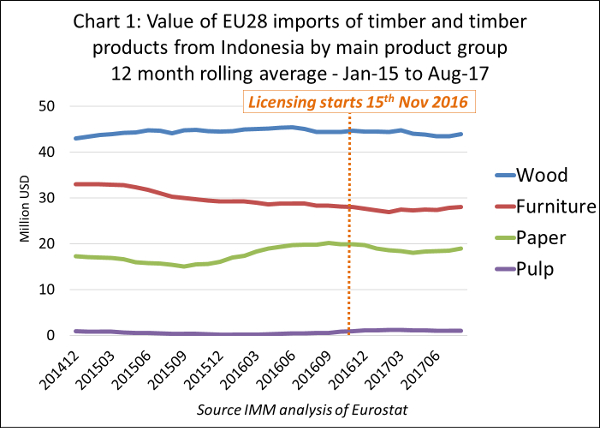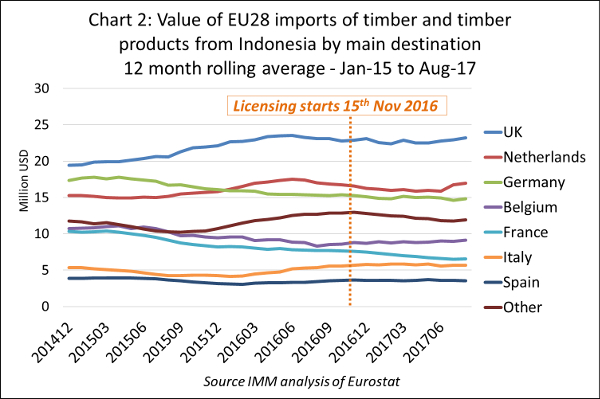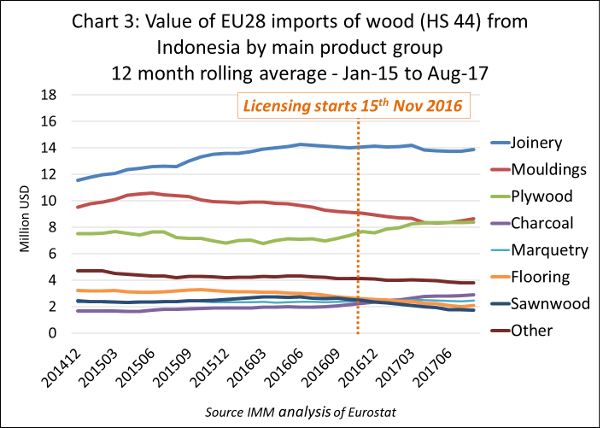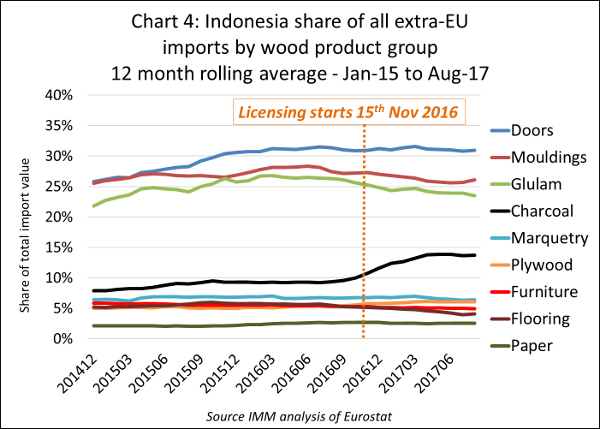Alongside regular surveys of market opinion to assess the market impact of FLEGT licensing, IMM is implementing near-real time monitoring of trade flow statistics. Early results of this monitoring indicate that there has been little immediate effect of the licensing system to either boost or impair timber trade between Indonesia and the EU. In fact, the value and volume of Indonesian trade with the EU has changed very little since the first licenses were issued in November 2016, while Indonesia’s share of the EU market has also remained stable.
Chart 1 shows the trend of EU timber imports from Indonesia by major product group as defined in the internationally harmonised system (HS) of product codes. The chart shows 12-month rolling average data to remove short-term variability and highlight long term trends. Data in US dollars is shown as the impact on export value is the most relevant measure for Indonesian suppliers.

In the 9 months following introduction of licensing, EU imports of Indonesian wood (HS 44), furniture (HS 94) and paper (HS 48) were broadly flat. EU imports of Indonesian wood pulp (HS 47) increased a little from a negligible level.
Chart 2 shows the trend in imports of timber and timber products (that is all products in HS 44, 47, 48, and 94) by individual EU member countries. There was no clear step change in imports from Indonesia in the months following introduction of licensing by any EU country. During this period imports from Indonesia were flat in the UK, Germany, Italy, and Spain, and were declining in France. More positively, imports of Indonesian products gradually picked up into Belgium throughout 2017, and increased sharply in the Netherlands in July this year.

Chart 3 reveals that the trend in EU imports of some individual wood (HS 44) products has varied since introduction of licensing. There has been quite a sharp increase in EU imports of plywood since November 2017, lending support to anecdotal reports of EU plywood importers being encouraged to stock more Indonesian product due to licensing. Imports of Indonesian charcoal have also increased, interesting mainly because charcoal is one product not currently covered by the licensing system.

However, EU imports of Indonesian joinery products (mainly doors and a smaller quantity of glulam) and marquetry have been flat since November 2016. EU imports of Indonesian sawn wood (all S4S to comply with Indonesian export regulations), flooring, and moulding/decking products have continued to slide this year.
Analysis of market share also reveals no clear short-term impact of licensing on the relative position of most Indonesian products in the EU market. Chart 4 shows the trend in % share of Indonesia in EU imports (excluding internal EU trade) of the various timber products. Chart 5 shows the trend in Indonesia’s share of EU imports of the same products from tropical countries.

The charts reveal that Indonesia’s share of EU imports has increased in plywood and charcoal this year, but been flat in some product groups (doors, marquetry, paper), and declined in others (wood furniture, flooring, glulam and mouldings/decking).
These various trends reinforce the conclusion of the IMM 2015/2016 report, that licensing is unlikely to transform the market, at least in isolation or in the short-term. Improved market access will require long-term commitment both to effective implementation of the EUTR, and to wider market development strategies which build on FLEGT licensing to enhance reputation and encourage greater investment in the Indonesian wood products industry.
